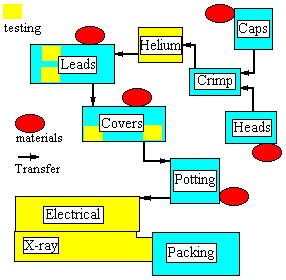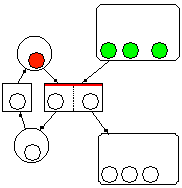Production line simulation.
McCann Science

Discrete event simulation of Production Processes and Petri-Net ideas.
 We had a client who wanted to
understand how his new factory for the automated fabrication of small items would perform
over a period of a few shifts, depending on the way it was managed at the hour by hour (or
less) level. The idea was not to provide a statistical evaluation of the long run
performance (though it turns out we could do that) but to show behaviour and let the team
commissioning the plant and running it see the effect of their decisions. There had been a
simulation of the plant made up before it was built, but after some difficulty getting it
working, we found that it missed some absolutely key features of the operations, meaning
that it really didn't serve as a plant model at all. By then, in the process of gathering
current performance data and checking some ideas, we had the beginnings of a simulation.
McCann Science then went on to make the special case into a freely available simulation
tool. In doing so we gave the client a simulator for training shift supervisors and
created a more general operations research (OR) tool. Read on, you may find your problems
reflected here. (More on the Production line example)
We had a client who wanted to
understand how his new factory for the automated fabrication of small items would perform
over a period of a few shifts, depending on the way it was managed at the hour by hour (or
less) level. The idea was not to provide a statistical evaluation of the long run
performance (though it turns out we could do that) but to show behaviour and let the team
commissioning the plant and running it see the effect of their decisions. There had been a
simulation of the plant made up before it was built, but after some difficulty getting it
working, we found that it missed some absolutely key features of the operations, meaning
that it really didn't serve as a plant model at all. By then, in the process of gathering
current performance data and checking some ideas, we had the beginnings of a simulation.
McCann Science then went on to make the special case into a freely available simulation
tool. In doing so we gave the client a simulator for training shift supervisors and
created a more general operations research (OR) tool. Read on, you may find your problems
reflected here. (More on the Production line example)
McSimAPN: a freely available interactive simulation tool for anyone.
McSimAPN is a McCann Science simulation tool, describing discrete event systems
by using timed Petri Net ideas. It's for easy use on personal computers, available to clients
and to anyone interested by a download from this website. It provides interactive
discrete event simulation alongside continuous systems simulation which allows users to run the
(model) factory or operation, make
changes on the fly, see activity and bottlenecks, stop and save conditions to come back
and try again.
McSimAPN has the following features:
- interactive operation, see results as the simulation runs, make changes, load and unload items, flip switches on the fly.
- all graphic interface, assemble, run modify.
- simple block structure with set of components designed for flexibility, hundreds of blocks allowed.
- stop and restart, save and come back to same point.
- models stored as text files, always editable by humans, but can be parsed into spreadsheets for parameterized modelling.
- run on any PC (Windows XP or later (I hope)) without going through a set-up procedure
- takes less than 1MB.
The display shows diagrammatically (as mimic block
diagram, which can imitate plant layout) the movement of items being processed,
the status of machines that handle them and the intermediate stores of items.
Bottlenecks show up as changes in color, spreading through the affected regions.
Equipment can be switched on and off "on the fly", stocks
replenished or depleted, even connections and routings between stages can
be changed or new routes added, on screen, without having to reset or
restart the model.
At any point the status (state) of the model
can be trapped and saved so that if it is necessary to
have another try (practice and training aid), that becomes easy.
Resources can be held for use on an item so that
they are not available for others, so things like transport, carriers and dies and tooling
and people can be shared between parts of the (model) plant or business
operation (logistics). Items can be batched up and processed as single units and split out
again. Yields on inspection or random routing is included.
As with most discrete event simulation tools, random timing
for processes is available and is readily changed to fixed timings. It's surprising how
irregular the apparent behaviour of a plant can become, just because of the complex
interactions, even with regular timings for the constituent processes.
The discrete event simulation model is stored as a simple text file so it can be edited easily. We have found it convenient to generate the text file from a spreadsheet so that the capabilities of a spreadsheet to put coordinated, calculated values in as timing, stock holding or other parameters can be exploited. In fact the program will read any text file, responding only to lines which have particular formatting to generate the simulation. The model can be generated entirely on screen, then saved, edited, parsed into a spreadsheet extended and regenerated there, but it is always readable by a human being. The underlying timing is deliberately simple, stepping along at regular (adjustable) intervals and thereby avoiding the object oriented, event chain complications and also making saving and restoring easy.
The whole program needs no installation ... just run it.
It takes up less than 1MB, including the Help files.
What's more, it is now incorporated with the analog computer programme so both can take part in the same model.
It runs with a graphical interface under Windows XP.
 The essential idea is that items being processed are assumed
indistinguishable. (It is therefore a monochromatic timed Petri net.) That is what
makes the programme so simple.
So although it won't easily cope with
(modelling the) processing of items which each have different characteristics, it turns
out that in many cases the location of an item in the system defines its attributes and
hence its interactions with the processes.
The essential idea is that items being processed are assumed
indistinguishable. (It is therefore a monochromatic timed Petri net.) That is what
makes the programme so simple.
So although it won't easily cope with
(modelling the) processing of items which each have different characteristics, it turns
out that in many cases the location of an item in the system defines its attributes and
hence its interactions with the processes.
However, if you need to track individual
items all the way through, then a more powerful (and expensive) discrete event simulation
tool is needed. (see our comments on simulation tools).
You may well find that McSimAPN will do a lot of the things you thought you needed a
powerful, expensive discrete event simulation language to do. If you would like to get a
free copy (with outline explanatory documentation), then you can download
it from here. This version is fully functional, but but we can't offer support
unless you contact us. After unZip, start with the file "readmefirst.txt"
Or, for direct contact send an email request to McCann Science, giving your phone
number and which time zone you are in.
Home/Index Page
About McSc
Summary
Principal (CV)
Contacting us
Contact in UK
Location USA
Philosophy
Software Tools
Fees
CAD service
Business & Commerce
TV Advertising
Drugs Competition
Housing Demand
Automobiles Demand
Wallcoverings Battle
Cash Flow
Human Resources
Project Management
Patent Analysis
Chemical Industry
Cooling Tower
Fermentation
Polymer Process
Heat exchange
Supercritical Fluid
Distributed parameter
Toxic gas allocation
Electrical
Control systems
Initiation systems
Ferrite Filters
Microstrip Antennas
Lightning
Production & Process
Automated manufacture
Crimp and Press
Glass making
Glass molding
Glass to metal seals
Heat exchanger
Helium Leak Testing
RF Soldering
Vacuum web coating
If you have a problem with the behaviour of a market sector, plant, process or item of equipment and would like to get a quantitative handle on it to improve yield or optimise performance, then contact us. We are always ready to give a little time to discuss a new puzzle, in confidence, of course. We'll only worry about fees when we have some defined work. We can be flexible about how we work with you.
Top
POB 902,
Chadds Ford PA
19317 USA.
T: 1 302 654-2953
F: 1 302 429 9458
E: mjmccann@iee.org
File: Mksim.htm
 Applications
Applications